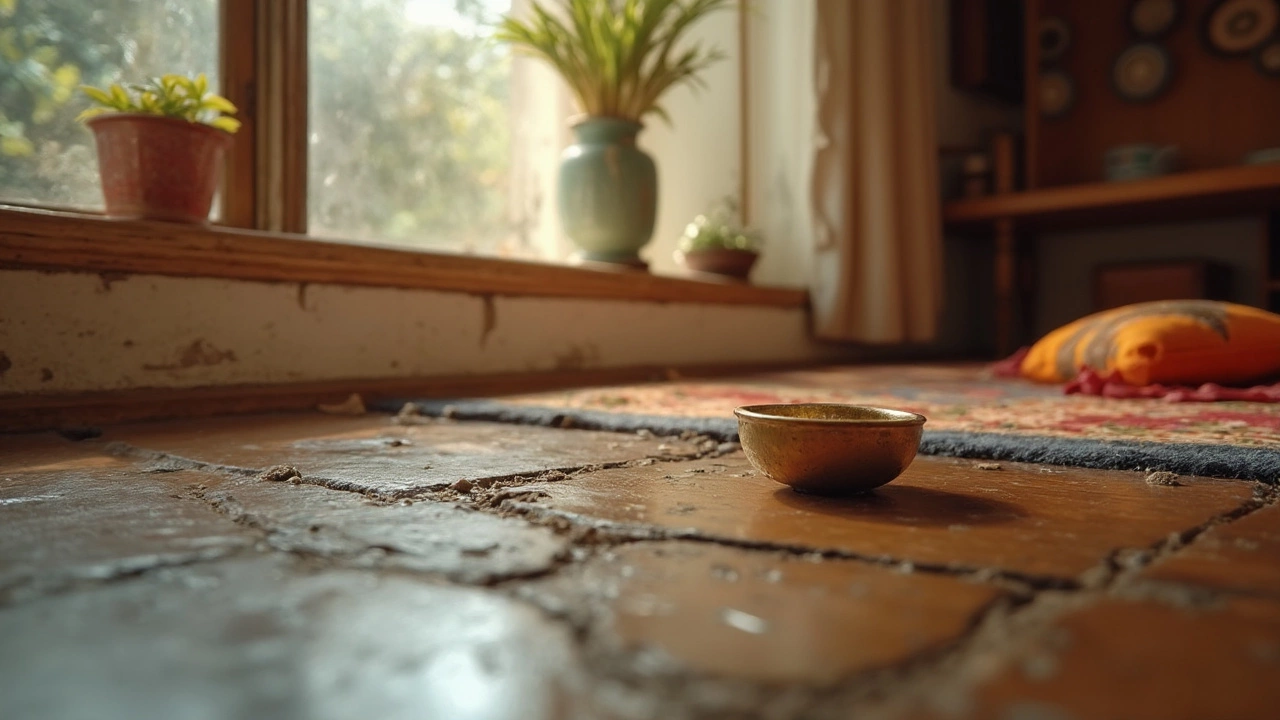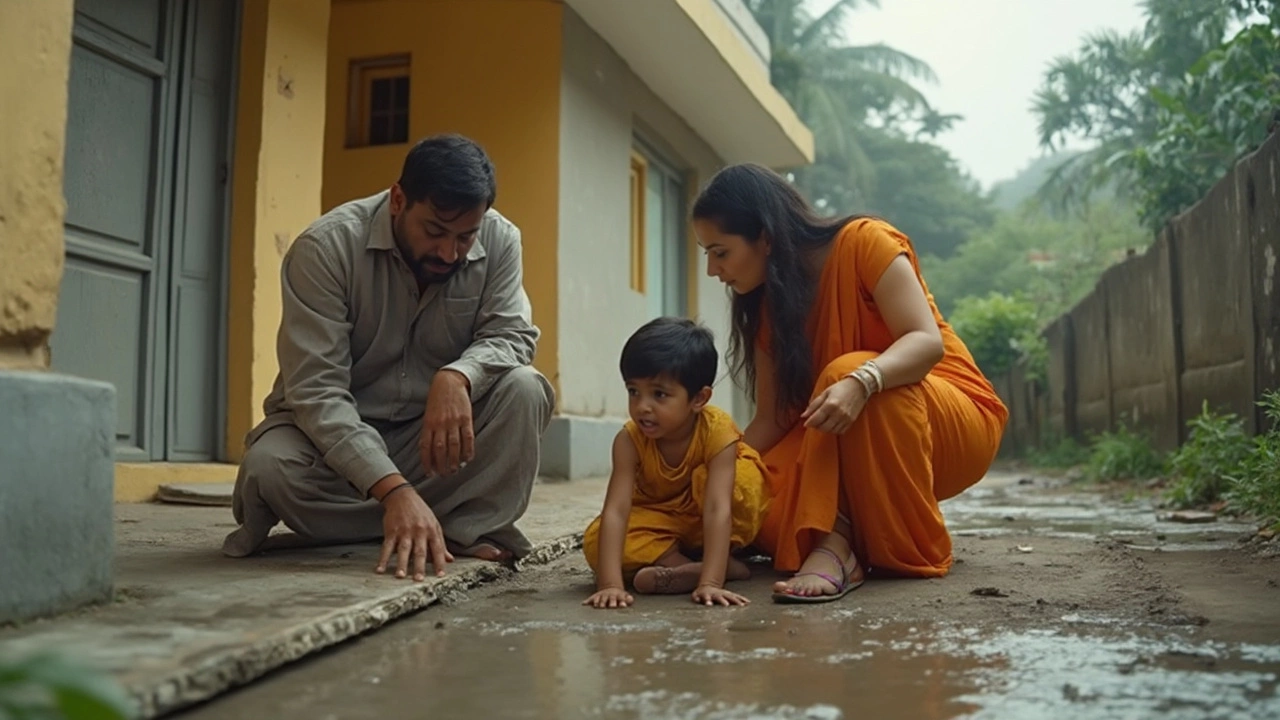Water Damage to Foundation: What It Looks Like and How to Spot It

Water damage in your foundation doesn’t scream for attention early on. It’s sneaky. Most people don’t notice the real signs until the problem gets a lot worse—and repairs get expensive. You might see some cracks in your basement walls or floor and think it’s nothing, but that can be the first hint that water is getting in where it shouldn’t.
Another big giveaway? Persistent pools of water around the outside of your house after it rains. If water never seems to drain away from your foundation, that’s a not-so-subtle warning. Moldy smells or damp spots in your basement are like waving a giant red flag. Even warped or uneven floors upstairs can trace back to a soggy foundation below. Don’t brush off musty air or a cold, clammy basement—these are clues your house is trying to give you.
Save yourself a headache (and wallet-ache) later by learning what these signs mean and catching them early. Everyone thinks it won’t happen to them—until it does. Knowing what foundation water damage actually looks like is the first step to keeping your house, and your sanity, in one piece.
- Big Red Flags: Common Signs of Water Damage
- Small Clues You Might Miss
- How Water Damages Your Foundation
- What Causes Foundation Water Damage?
- DIY Checks: What You Can Do Right Now
- When to Call a Pro (and What to Expect)
Big Red Flags: Common Signs of Water Damage
Some signs of water damage in your foundation show up way before others. If you catch these early, you’ll save tons of money and headaches. First up, be on the lookout for big, new cracks in your basement walls or floor. A hairline crack isn’t much to worry about, but anything thicker than a quarter, that’s a red alert. Cracks that suddenly appear and keep growing usually mean water is pressing against your foundation and forcing its way in.
Another clear giveaway is water stains, especially those weird, dark patches on the concrete. When water leaks through, it takes dirt and minerals with it, leaving behind stains or white powdery stuff called efflorescence. If you spot these, it’s a good bet you’ve got a water problem hiding just out of sight.
Got standing water in your basement after rain? That’s a huge sign your foundation’s losing the battle. But even if water’s not pooling, pay attention to a musty smell. Mold and mildew love dark, wet spaces, and if you can smell them, water is hanging around where it shouldn’t. You might also see paint bubbling or drywall starting to bulge on finished basement walls.
Uneven, sagging floors upstairs can also be tied back to foundation issues caused by water damage. If your windows or doors are getting hard to open or close, don’t just blame the wood - your foundation could be shifting. These symptoms are often tied to long-term water problems, not just an unlucky rainy season.
- Thick, growing cracks in basement walls or floors
- Water stains or efflorescence on concrete
- Standing water or obvious wet spots after rain
- Musty smells hinting at mold or mildew
- Bubbling paint, bulging drywall, or warped trim
- Floors that sag or feel bouncy upstairs
- Sticking doors or windows around the house
If you spot a few of these at the same time, your home is practically shouting for help. According to the American Society of Home Inspectors, over 60% of homes in the U.S. have underground moisture problems. So, more people deal with foundation repair than you’d expect.
Small Clues You Might Miss
Sometimes water damage is sneaky and doesn’t show up as dramatic cracks or puddles. A lot of folks ignore these smaller hints, but catching them early can save you a fortune on foundation repair. Here are low-key signs to put on your radar:
- Sticky doors and windows: If a door that used to swing open easily now scrapes or gets stuck, the frame might be warping. That can happen when a foundation shifts from excess moisture below.
- Hairline cracks: Not all cracks are the same. Hairline ones that zigzag along walls or floors—even if they seem harmless—could mean water has started messing with your home’s support.
- Efflorescence: This is just a fancy word for those white, chalky streaks on your basement’s concrete or bricks. It happens when water evaporates, leaving behind mineral deposits. If you wipe it and it comes back, there’s a leak somewhere.
- Musty smell: That lingering basement funk? It’s often caused by mold or mildew from trapped moisture—a classic sign of water damage in your foundation or basement.
- Bubbling paint or peeling wallpaper: Water tends to push paint or wallpaper away from the wall, leading to odd bubbles or rough patches, especially down low.
If you want some numbers, according to the International Association of Certified Home Inspectors, over 60% of homes in the U.S. have some form of underground moisture. So these "small clues" aren’t rare—they’re almost expected for homeowners eventually.
Whenever you spot more than one of these, don't just shrug it off. Walk around and check if there’s a pattern in where issues pop up. Sometimes just moving a box or lifting a corner of a rug in your basement can reveal dampness or that all-too-familiar smell.
Bottom line: if you notice these signs, it’s smart to keep an eye on them and take action early. The sooner you address foundation issues from water damage, the easier—and cheaper—the fix will be.
How Water Damages Your Foundation
When water hangs around your house, it doesn’t just look bad—it goes right to work on your foundation. You might think concrete and stone are rock solid, but water can slip into the tiniest cracks and slowly eat away at both.
Here’s what actually happens: When it rains or snow melts, water collects around your home. If the ground can’t absorb it fast enough, it puts a lot of pressure—"hydrostatic pressure" if you want the technical term—against your foundation walls. This builds up until water finds a way in, either through cracks or the area where the wall meets the floor.
Too much water damage leads to several classic problems:
- Cracks in Walls and Floors: Water pressure literally pushes your foundation apart, causing noticeable cracks. These cracks let in more water, making things worse over time.
- Mold and Mildew: Dampness is perfect for mold. You’ll know it’s there from the musty smell even before you see any spots.
- Foundation Shifting: If water washes away the soil under your home (called “soil erosion”), your foundation can shift or settle unevenly. This causes doors and windows to stick and sometimes floors to slope.
- Rust and Rot: If your basement has any steel supports or wooden framing, constant moisture causes rust and wood rot, both of which weaken the whole structure.
Check out how fast water can make a difference. According to home inspection data from 2023, homes with poor drainage are 60% more likely to have foundation repair needs within 10 years compared to those with proper grading and gutters.
| Source of Water | Main Risk | Common Result |
|---|---|---|
| Poor drainage | Ongoing exposure | Cracks and mold |
| Plumbing leaks | Hidden inside/outside | Damp spots & rot |
| Heavy rainfall/flooding | Sudden overload | Foundation settlement |
Bottom line? Water’s sneaky, and it attacks your foundation in several ways. That’s why tackling leaks and drainage issues as soon as you spot them is the smartest move for any homeowner.

What Causes Foundation Water Damage?
Most foundation problems start with water getting where it shouldn’t. The usual suspects boil down to a few main things, and knowing these can save you from a ton of hassle.
Here are the top things that cause water damage to your home's foundation:
- Poor drainage: If your yard doesn’t slope away from the house or your gutters are clogged, water can pool right next to your foundation. Over time, this water seeps down and causes cracks or shifts.
- Heavy rain and flooding: Big storms dump a lot of water at once, and if your drainage can’t keep up, water ends up soaking the concrete and soil around your home.
- Plumbing leaks: Sometimes the problem isn’t even outside. A busted pipe under your basement slab or in your crawl space can slowly leak water directly into the area around your foundation.
- Bad grading: If the ground around your house is flat or slopes toward the foundation, water won’t drain away like it should. This puts constant pressure on your foundation walls.
- Hydrostatic pressure: Soil gets saturated after a heavy rain or when your water table rises. All that water builds up a ton of pressure against your basement walls, pushing moisture inside and causing cracks.
A study by the American Society of Home Inspectors found that improper surface grading causes almost 35% of foundation issues in homes across the US. If you’re seeing water pooling by your house after a storm, you’re not alone.
| Cause | How It Damages Foundations |
|---|---|
| Poor Drainage | Lets water collect and seep next to foundation |
| Flooding | Overloads soil and foundation with water |
| Plumbing Leaks | Leaks inside home soak soil under foundation |
| Bad Grading | Improper slope sends water toward house |
| Hydrostatic Pressure | Buildup of pressure cracks walls, lets in water |
Sometimes it’s not just one thing—it could be a combination. Maybe clogged gutters and a leaky pipe are both working against you. That’s why regular checks are so important. Catching these early means you might avoid major foundation repair bills down the road.
DIY Checks: What You Can Do Right Now
It’s tempting to ignore those basement walls, but checking for water damage doesn’t have to be a hassle. You can spot a lot of issues yourself before calling in the pros. Grab a flashlight and don’t be afraid to poke around. Here’s what you should look for right now:
- Check for cracks: Look at both the inside and outside of your basement or foundation. Small hairline cracks aren’t always serious, but wide cracks (anything thicker than a quarter) could mean water’s got in.
- Feel (and sniff) for dampness: Run your hand along foundation walls and floors. If it feels damp, chilly, or smells musty, there’s probably moisture. A musty smell is a dead giveaway for hidden water damage.
- Look for efflorescence: This is a powdery white residue on walls—a classic sign that water is seeping through concrete.
- Inspect around your home’s exterior: Make sure the ground slopes away from your foundation, not toward it. Standing water after rain is a sign of poor drainage and can quickly cause foundation repair hassles.
- Watch out for rust: Rusting metal posts, supports, or spots near basement windows mean there has been prolonged moisture exposure.
If you’re not sure what normal looks like, keep a simple log of spots you’re worried about. Take some pictures to compare next month. Even a cat like Luna could spot something weird if she keeps avoiding a damp, musty basement!
| Sign | What It Means |
|---|---|
| Large cracks | Possible structural problem, often from water damage |
| Efflorescence | Water is moving through concrete or masonry |
| Musty odor | Moisture or mold growth present |
| Pooling water | Poor drainage around foundation, risk for bigger problems |
You don’t need to crawl around in the mud or become a basement hermit. Quick checks every few months are enough to catch foundation repair issues early, before they drain your budget.
When to Call a Pro (and What to Expect)
Trying to fix water damage to your foundation by yourself is risky, especially when the signs are big—think serious cracks, pooling water, or mold that keeps coming back even after you clean. If you spot anything structural, like bowing walls or doors that just won’t shut right, it’s time to skip the DIY videos and call a foundation repair expert. These are not just surface issues. They could mean the whole foundation is weakening.
So what actually happens when you call a pro? First, most companies offer a free inspection. Someone will come out, usually within a week, and check for things like cracks, leaks, and moisture levels. They’ll use moisture meters, flashlights, and sometimes even tiny cameras to see inside wall gaps and under the slab. Here’s what you’ll usually get from a proper inspection:
- Visual check for cracks and shifting
- Tests for moisture with special meters
- Inspection for mold or musty smells
- Looking at your basement or crawlspace for standing water
- Advice about next steps—like immediate repairs or even outside drainage fixes
After the inspection, you’ll get a breakdown of what’s wrong and a quote (sometimes a couple options for different repair levels). Repairs might mean patching up basement cracks, installing a sump pump, fixing drainage, or sealing up the outside—depends on how bad things are. If you see numbers on a quote that shock you, know this: bankrate.com says the average homeowner spends between $2,000 and $7,000 on serious foundation issues. Simple fixes like small cracks or sealing usually cost less, but bigger problems are never cheap.
Remember: the earlier you catch foundation repair problems, the simpler (and cheaper) the fix. Waiting only means more damage, higher bills, and—worst case—major safety risks. So if your gut says something’s off or the free inspection turns up issues you don’t understand, get a second opinion from another pro. And if you have pets like my cat Luna, keep them away from damaged areas and any repair crews to stay safe.


